Complete Solutions to JEE (Main and Advanced) of chapter WORK, ENERGY AND POWER of Class 11 book with complete answers and questions
| Class 11 | PHYSICS |
| Chapter | WORK, ENERGY AND POWER |
| PRADEEP | JEE (Main and Advanced) |
| Number Of Questions | 82 |
| Academic Year | 2023-24 |
A particle moves along a curve of unknown shape but magnitude of force `F` is constant and always acts along tangent to the curve.Then
01:48View SolutionA bolck of mass `10 kg` is moving in x-direction with a constant speed of `10 m//s`. it is subjected to a retardeng force `F=-0.1 x J//m`. During its travel from `x =20m` to `x =30 m`. Its final kinetic energy will be .
03:38View SolutionA partical of mass `m` is driven by a machine that deleveres a constant power `k` watts. If the partical starts from rest the force on the partical at time `t` is
03:59View SolutionA force `F=(10+0.50x)` acts on a particle in the x direction, where F is in newton and x in meter. Find the work done by this force during a displacement from x=0, ox=2.0m
01:48View SolutionA body of mass `1kg ` begins to move under the action of a time dependent force `vec(F)=(2t hat(i)+3t^(2) hat(j))N`, where `hat (i) ` and `hat(j)` are unit vectors along `X` and `Y` axis. What does will be developed by the source at time `t` ?
04:28View SolutionA point particle of mass m, moves long the uniformly rough track PQR as shown in figure. The coefficient of friction, between the particle and the rough track equals `mu`. The particle is released, from rest from the point P and it comes to rest at a point R. The energies, lost by the ball, over the parts, PQ and QR, of the track, are equal to each other, and no energy is lost when particle changes direction from PQ to QR.
The value of the coefficient of friction `mu` and the distance x `(=QR)`, are, respectively close to:
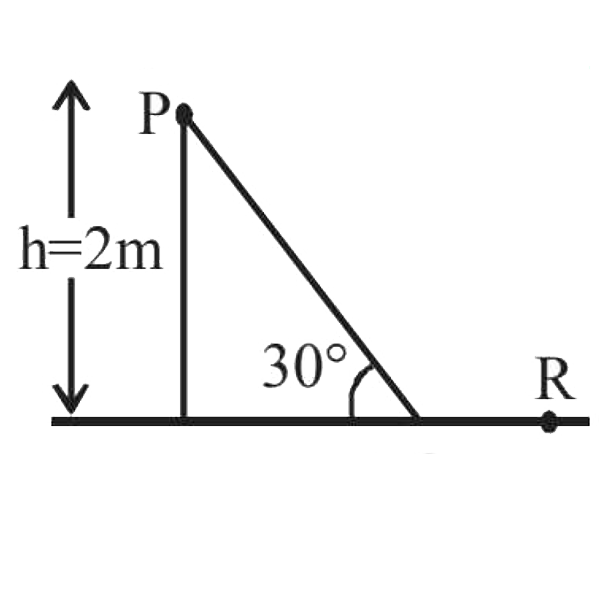 04:21View Solution
04:21View SolutionA person trying to lose weight by burning fat filts a mass of `10 kg` upto a being of `1m 1000` time . Assume that the potential energy lost each time be lower the mass is dissipated . How much far will be use up considering the work done only when the weight is lifted up ? Far supplies `3.8 xx 10^(7) J` of energy per kg wich is canverted to mechanical energy with `x 20 %` efficiency rate Take ` = 9.8 ms^(-2)`
03:50View SolutionA water cooler of storages capacity 120 liters can cool water at a constant rate of P watts. In a closed circulation system (as shown schematically in the figure), the water from the cooler is used to cool an external device that generates constantly 3kW of heat (thermal load). The temperature of water fed into the device cannot exceed `30^@C` and the entire stored 120 liters of water is initially cooled to `10^@C.` The entire system is thermally insulated. The minimum value of P ( in watts) for which the device can be operated for 3hours is
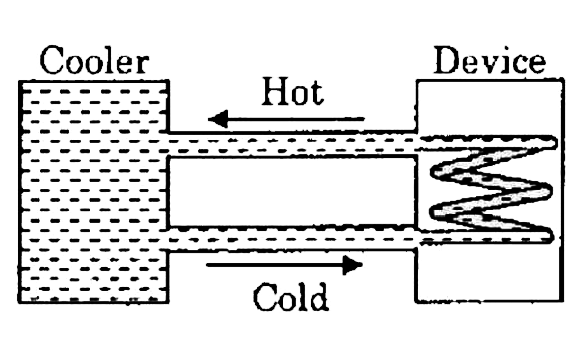
(Specific heat of water is `4.2kJkg^-1K^-1` and the density of water is `1000kgm^-3`)09:42View SolutionA block of mass `10 kg` is moving in x-direction with a constant speed of `10 m//s`. it is subjected to a retarding force `F=-0.1 x J//m`. During its travel from `x =20m` to `x =30 m`. Its final kinetic energy will be.
03:38View SolutionTwo similar springs `P` and `Q` have spring constants `K_(P)` and `K_(Q)`. They are stretched first by the same amount `(` case `a)`,then by the same force `(` case `b)`. The work done by the spring `W_(P)` and `W_(Q)` are relased as, in case `(a)` and case `(b)`, respectively.
03:26View SolutionA partical of mass `m` is driven by a machine that deleveres a constant power `k` watts. If the partical starts from rest the force on the partical at time `t` is
03:59View SolutionA ball is projected vertically down with an initial velocity from a height of `20 m` onto a horizontal floor. During the impact it loses `50%` of its energy and rebounds to the same height. The initial velocity of its projection is
05:46View SolutionA rod of mass `m` and length `l` is lying on a horizontal table. Work done in making it stand on one end will be
03:31View SolutionA body of mass `m=10^(-2) kg` is moving in a medium and experiences a frictional force `F=-KUPSILON^(2).` Its initial speed is `upsilon_(0)=10ms^(-2)`. If , after `10s`, its energy is `(1)/(8)m upsilon_(0)^(2)`, the value of `k` will be
04:51View SolutionA time dependent force `F=6t` acts on a particle of mass `1kg`. If the particle starts from rest, the work done by the force during the first `1 sec.` will be
03:57View SolutionA long spring when stretched by `x cm`, has a potential energy `U`. On increasing the stretching to `nx cm,` the potential energy stored in spring will be
02:14View SolutionA body of mass `m` is acceleratad uniformly from rest to a speed `v` in a time `T` . The instantaneous power delivered to the body as a function of time is given by
02:01View SolutionA lorry and a car moving with the same kinetic energy are brought to rest by the application of brakes which provides equal retarding forces. Which of them will come to rest in a shorter distance?
03:08View SolutionIt is well known that a rain drop falls under the influence of the downward gravitational force and the opposing resistive force. The latter is known to be proportional to the speed of the drop, but is otherwise undetermined. Consider a drop of mass 1.0g falling from a height of 1.00km. It hits the ground with a speed of `50.0ms^(-1)` (a) What is the work done by the gravitational force ? (b) What is the work done by the unknown resistive force ?
04:27View SolutionAt sea level, a `N_(2)`, molecule in air has an average translational `KE=6.2xxx10^(-21)J`. Its mass is `4.7xx10^(-26)kg.` If the molecule shoots up straight without any resistance, it will risw to a height of
03:55View SolutionMomentum of a particle is increased by `50%`. By how much percentage kinetic energy of particle will increase?
04:22View SolutionAn explosion blows a rock into three parts. Two parts go off at right angles to each other . These two are `1 kg` first part moving with a velocity of `12 ms^(-1) and 2 kg` second part moving with a velocity of `8 ms^(-1)`. If the third part flies off with a velocity of `4 ms^(-1)`. Its mass would be
02:21View SolutionA uniform force of `(3 hat(i)+hat(j))` newton acts on a particle of mass `2 kg`. Hence the particle is displaced from position `(2 hat(i)+hat(j))` meter to position `(4 hat(i)+ 3hat(j)-hat(k))` meter. The work done by the force on the particle is `:`
02:37View SolutionA ball of mass 0.2 kg is thrown vertically upwards by applying a force by hand. If the hand moves 0.2 m while applying the force and the ball goes upto 2 m height further, find the magnitude of the force. (Consider `g=10m//s^2`).
03:42View SolutionThe velocity of a particle at which the kinetic energy is eqyal to its rest mass energy is
03:42View SolutionA running man has the same kinetic energy as that of a boy of half his mass. The man speed up by `2 ms^(-1)` and the body changes his speed by `x ms^(-1)` so that the kinetic energies of the boy and the man are again equal. Then `x` in `ms^(-1)` is
05:21View SolutionIf the potential energy of a gas molecule is `U=(M)/(r^(6))-(N)/(r^(12)),M ` and `N` being positive constants, then the potential energy at equlibrium must be
04:12View SolutionIn which case does the potential energy decrease ?
05:05View SolutionThe `K.E.` acquired by a mass `m` in travelling a certain distance `d`, starting from rest, under the action of a constant force is directly propotional to
02:22View SolutionA body of mass` 5 kg` is moving with a momentum of `10 kg m//s`. A force of `0.2 N` acts on it in the direction of motion of the body for `10 sec.` The increase in its kinetic energy.
03:23View SolutionA body is moving undirectionally under the influence of a source of constant power. It displacement in time t is proportional to (i) `t^(1//2)` (ii) t (iii) `t^(3//2)` (iv) `t^(2)`
03:50View SolutionA bullet fired into a fixed target loses half of its velocity after penetrating 3cm. How much further it will penetrate before coming to rest assuming that it faces constant resistance to motion?
04:16View SolutionIt requires 20 turns of the stem of a watch to wind the main spring and this stores sufficient energy to keep the watch running for `30 hrts.` If 10 turns are given to thestem, the watch will run for
02:59View SolutionThe potential energy of a `1 kg` particle free to move along the x- axis is given by `V(x) = ((x^(4))/(4) - x^(2)/(2)) J`
The total mechainical energy of the particle is `2 J` . Then , the maximum speed (in m//s) is03:33View SolutionA body of mass `3 kg` is under a constant force which causes a displacement `s` metre in it, given by the relation `s=(1)/(3)t^(2)`, where `t` is in seconds. Work done by the force in 2 seconds is
02:46View SolutionA vertical spring with force constant `k` is fixed on a table. A ball of mass `m` at a height `h` above the free upper end of the spring falls vertically on the spring , so that the spring is compressed by a distance `d`. The net work done in the process is
01:11View SolutionA `2kg` block slides on a horizontal floor with the a speed of `4m//s` it strikes a uncompressed spring , and compresses it till the block is motionless . The kinetic friction force is compresses is `15 N` and spring constant is `10000 N//m` . The spring by
03:58View SolutionWater falls from a height of `60 m` at the rate `15 kg//s` to operate a turbine. The losses due to frictional forces are `10%` of energy . How much power is generated to by the turbine? (`g=10 m//s^(2))`.
01:33View SolutionAn engine pumps water continously through a hose. Water leave the hose with a velocity `v` and `m` is the mass per unit length of the Water jet. What is the rate at Which kinetic energy is imparted to water?
02:43View SolutionA block of mass`2` kg is from to move along the x - axis it is at rest and from `1 = 0` onwards it is subjeted to a time - depended force `F(i) ` in the `x` diretion . The force `F(1) ` varies with `1` as shown in the figure . The kinetic of the block after `4.5` second is
 04:50View Solution
04:50View SolutionThe potential energy funtions for the force between two along in a distance molecule is approximately given by
`U(x) = (a)/(x^(12)) - (b)/(x^(6)) ` where `a` and `b` are constant and `x` is the distance between the aloms , if the discision energy of the molecale is `D = [U(x = oo) - U` atequlibrium ] , D is03:53View SolutionAn engine pumps water through a hose pipe. Water passes through the pipe and leaves it with a velocity of `2 ms^(1)`. The mass per unit length of water in the pipe is `100 kgm^(-1)`. What is the power of the engine?
02:49View SolutionA man of `50 kg` mass is standing in a gravity free space at a height of `10m` above the floor. He throws a stone of `0.5 kg` mass downwards with a speed `2m//s`. When the stone reaches the floor, the distance of the man above the floor will be
04:58View SolutionExpress (a) the energy required to break one bond in DNA `(10^(-10)J)` in eV.
(b) the kinetic energy of an air molecule `(10^(-21)J)` in eV.
(c) the daily intake of a human adult `(10^(7)J)` in kilo-calories.03:55View SolutionIf a spring of stiffness `'k'` is cut into two parts `'A'` and `'B'` of length `l_(A):l_(B)=2:3`, then the stiffness of spring `'A'` is given by
02:26View SolutionAt time `t=0s` particle starts moving along the `x-` axis. If its kinetic energy increases uniformly with time `'t'`, the net force acting on it must be proportional to
03:36View Solutionforce `F` on a particle moving in a straight line veries with distance `d` as shown in the figure. The work done on the particle during its displacement of `12 m` is
 01:14View Solution
01:14View SolutionThe potential energy of a particle in a force field is:
`U = (A)/(r^(2)) - (B)/(r )`,. Where `A` and `B` are positive
constants and `r` is the distance of particle from the centre of the field. For stable equilibrium the distance of the particle is03:15View SolutionA car of mass `m` starta from rest and accelerates so that the instyantaneous power delivered to the car has a constant magnitude `P_(0)`. The instaneous velocity of this car is proportional to
00:57View SolutionTwo point masses 1 and 2 move with uniform velocities `vec(v)_(1)` and `vec(v)_(2)`, respectively. Their initial position vectors are `vec(r )_(1)` and `vec(r )_(2)`, respectively. Which of the following should be satisfied for the collision of the point masses?
04:39View SolutionOn a friction surface a block a mass `M` moving at speed `v` collides elastic with another block of same mass `M` which is initially at rest . After collision the first block moves at an angle `theta` to its initial direction and has a speed `(v)/(3)`. The second block's speed after the collision is
01:55View SolutionFigure shows a smooth curved track terminating in a smooth horizontal part. A spring of spring constant 400 N/m is attached at one end of a wedge fixed rigidly with the horizontal part. A 40 g mas is released from rest at a height of 4.9 m n the curved track. Find the maximum compression of the spring.
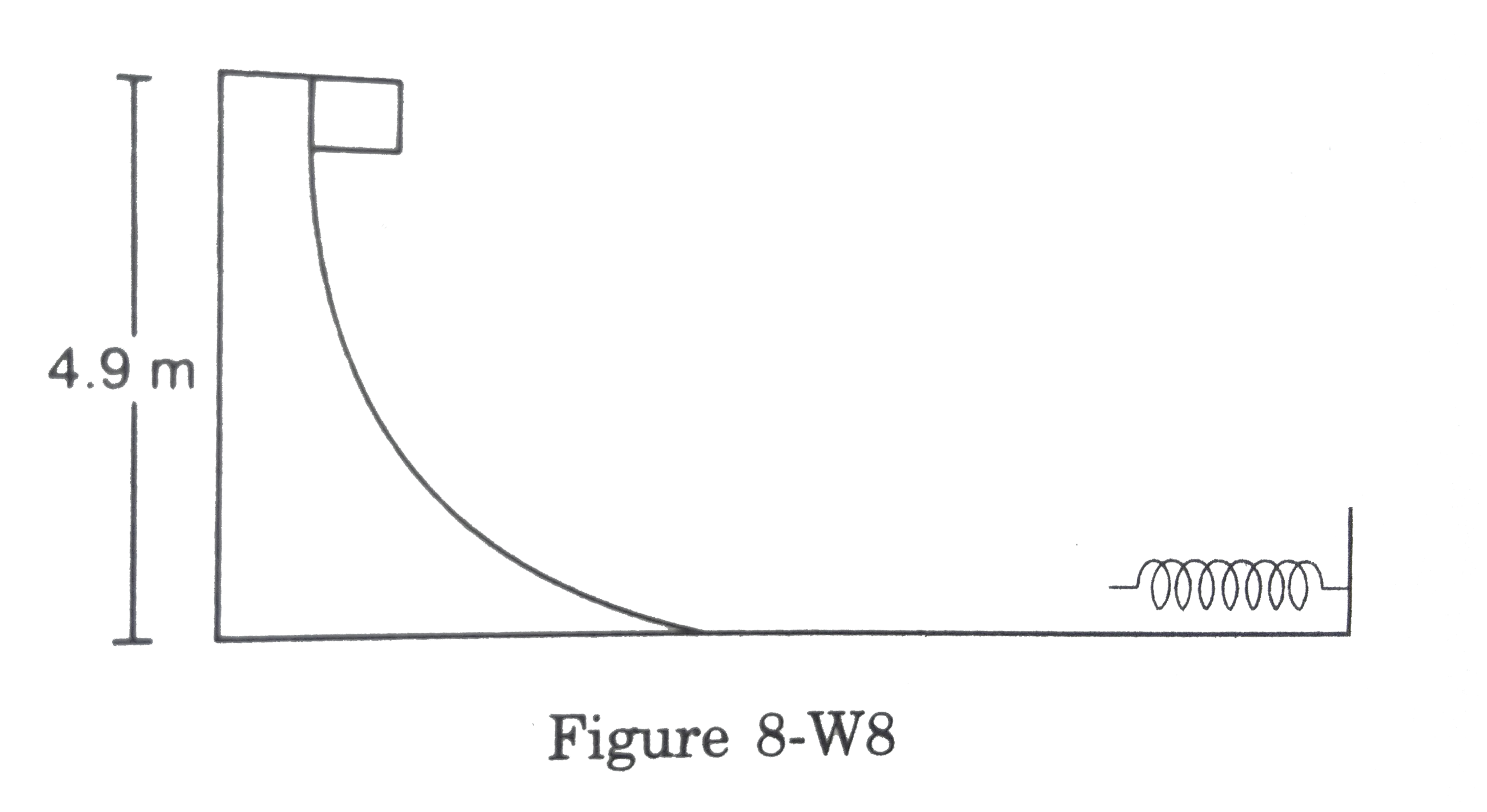 04:37View Solution
04:37View SolutionA block of mass m moving at speed `upsilon` collides wilth another block of mass 2 m at rest. The lighter block comes to rest after the collision. Find the coefficient of restitution.
03:42View SolutionA particle of mass m moving in the x direction with speed 2v is hit by another particle of mass 2m moving in they y direction with speed v. If the collision is perfectly inelastic, the percentage loss in the energy during the collision is close to :
05:15View SolutionA block of mass `0.50kg` is moving with a speed of `2.00m//s` on a smooth surface. It strikes another mass of `1 kg` at rest and they move as a single body. The energy loss during the collision is
04:10View SolutionTwo particles of masses `m_(1),m_(2)` move with initial velocities `u_(1)` and `u_(2)`. On collision, one of the particles get excited to higher level, after absorbing enegry. If final velocities of particles be `v_(1)` and `v_(2)` then we must have
03:07View SolutionA body of mass `m_(1)` collides elastically with another body of mass `m_(2)` at rest. If the velocity of `m_(1)` after collision is `(2)/(3)` times its initial velocity, the ratio of their masses is `:`
04:05View SolutionA heavy truck moving with a velocity of `60 km//h` collides with a light drum at rest. If the collision is elastic, then the velocity of the drum immediately after collision will be
04:55View SolutionA bullet hits and gets embedded in a solid block resting on a frictionless surface. In this process, which of the following is correct ?
03:43View SolutionA bullte weighing `5 g` and moving with a velocity `600 m//s` strikes a `5 kg` block of ice resting on a frictionless surface. The speed of the block after the collision is
02:47View SolutionTwo perfectly elastic particles `A` and `B` of equal masses travelling along a line joining them with velocities `15 m//s` and `10m//s` respectively collide. Their velocities after the elastic collision will be (in m/s) respectively
05:09View SolutionA ball moving with velocity `2 ms^(-1)` collides head on with another stationary ball of double the mass. If the coefficient of restitution is `0.5`, then their velocities (in `ms^(-1)`) after collision will be
05:49View SolutionA ball of mass `1 kg` moving with velocity `3 m//s`, collides with spring of natural length `2m` and force constant `144 N//m` . What will be length of compressed spring ?
03:25View SolutionA ball is dropped on the ground from a height of `1m`. The coefficient of restitution is `0.6`. The height to which the ball will rebound is
02:42View SolutionA shell is fired from a cannon with a velocity `v (m//sec.)` at an angle `theta` with the horizontal direction. At the highest point in its path it explodes into two pieces of equal mass. One of the pieces retraces its path to the cannon and the speed (in `m//sec.`) of the other piece immediately after the explosion is
03:48View SolutionAn object of mass `40kg` and having velocity `4 m//s` collides with another object of mass `60 kg` having velocity `2 m//s` . The loss of energy when the collision is perfectly inelastic is
05:42View SolutionA body of mass `5m` initially at rest explodes into 3 fragments with mass ratio `3:1:1.` Two of fragments each of mass `'m'` are found to move with a speed `60m//s` in mutually perpendicular direction. The velocity of third fragment is
04:08View SolutionParticle A makes a head on elastic collision with another stationary particle B. They fly apart in opposite directions with equal speeds. The mass ratio will be
04:02View SolutionThe first ball of mass `m` moving with the velocity `upsilon` collides head on with the second ball of mass `m` at rest. If the coefficient of restitution is `e`, then the ratio of the velocities of the first and the second ball after the collision is
04:49View SolutionA body of mass `2kg` moving with a velocity of `6 m//s` strikes inelastically another body of same mass at rest. The amount of heat evolved during collision is
05:12View SolutionA ball moving with a speed of `9m//s` strikes an identical ball at rest, such that after the collision, the direction of each ball makes an angle of `30^(@)` with the original line of motion. Find the speeds of the two balls after collision.
05:41View SolutionIf two masses `m_(1)` and `m_(2)` collide, the ratio of change in their respective velocities is proportional to
02:28View SolutionA wooden block of mass `10 gm` is dropped from the top of a tower `100m` high. Simultaneously, a bullet of mass `10 gm` is fired from the foot of the tower vertically upwards with a velocity of `100m//sec`, figure. If the bullet is embedded in it, how high will it rise above the tower before it starts falling ? (Consider `g=10m//sec^(2))`
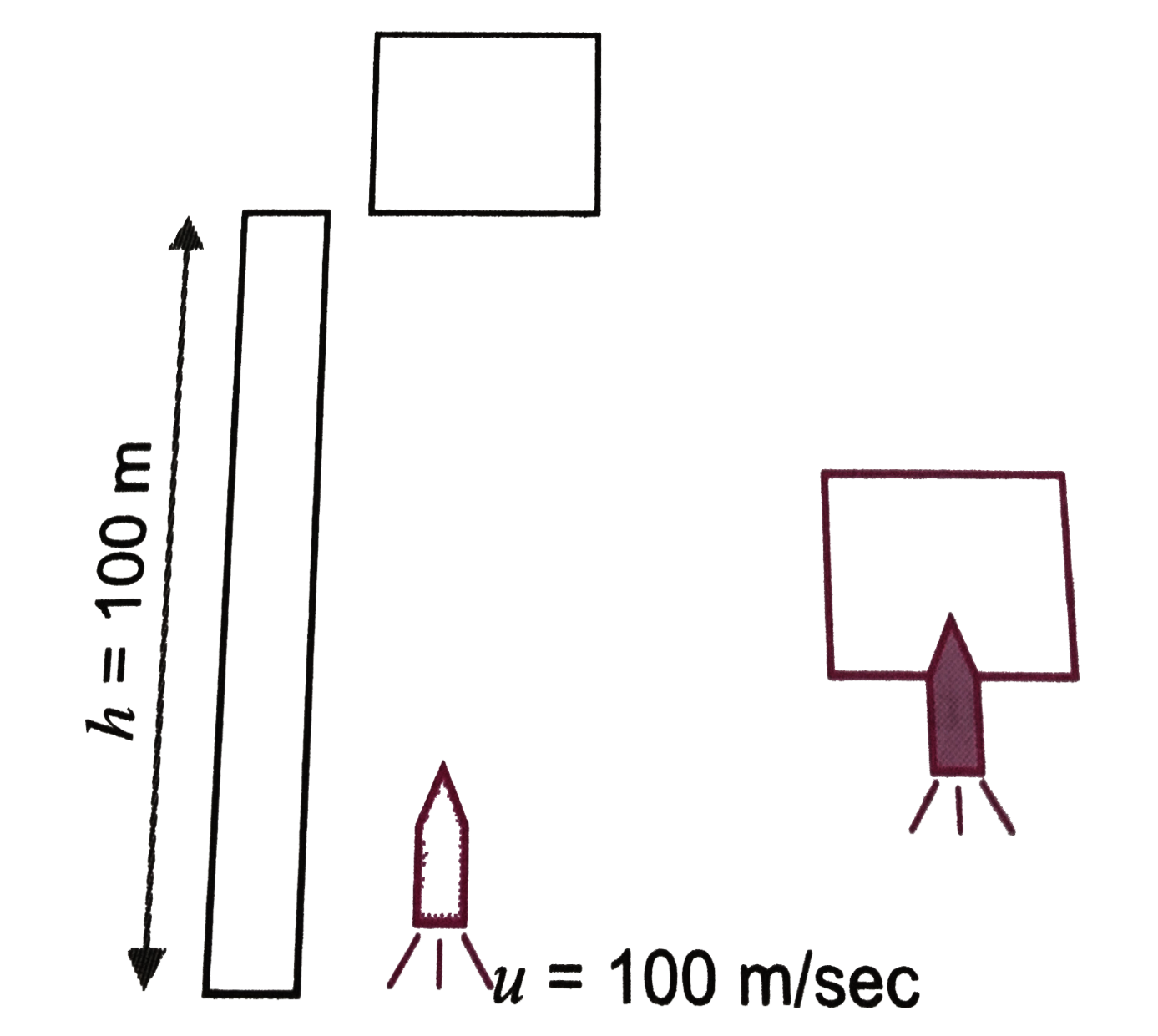 09:58View Solution
09:58View SolutionA car weighing `2xx10^(3)kg` and moving at `20 m//s` along a main road collides with a lorry of mass `8xx10^(3)kg ` which emerges at `5 m//s` from a cross road at right angles to the main road. If the two vehicles lock, what will be their velocity after the collision ?
07:54View SolutionA bom of mass `1 kg` is thrown vertically upwards with a speed of `100m//s`. After 5 seconds, it explodes into two fragments. One fragment of mass `400 gm` is found to go down with a speed of `25m//s`. What will happen to the second fragment just after the explosion ? `(g=10ms^(-1))`
06:06View SolutionA stationary partical explodes into two partical of a masses `m_(1) and m_(2)` which move in opposite direction with velocities `v_(1) and v_(2)`. The ratio of their kinetic energies `E_(1)//E_(2)` is
01:21View SolutionA block of mass `0.18 kg ` is attached to a spring of force constant `2 N//m` The coefficient of friction between the block and the force is `0.1` insitially its block is at rest and the block as spring is an streched , As impalse is given to the block as shown in the figure . The block sides a distance of ` 0.06` in and comes to the first time . The initial velocity of the for blocks is mis `V = N 10` then `N` is .
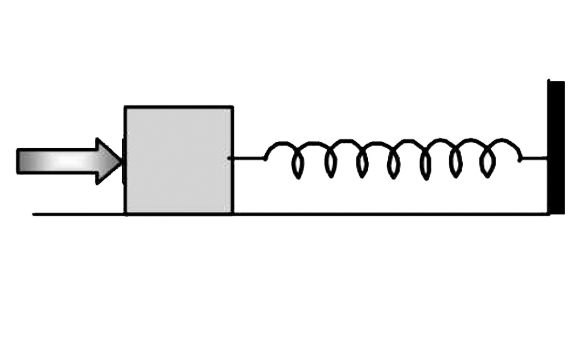 03:33View Solution
03:33View SolutionA solid cylinder of mass `3 kg` is rolling on a horizontal surface with velocity `4 ms^(-1)`. It collides with a horizontal spring of force constant `200 Nm^(-1)`. The maximum compression producec in the spring will be `:`
05:55View SolutionTwo sphere `A and B` of masses `m_(1) and m_(2)` respectivelly colides. A is at rest initally and `B` is moving with velocity `v` along x-axis. After collision `B` has a velocity `(v)/(2)` in a direction perpendicular to the original direction. The mass `A` moves after collision in the direction.
08:19View SolutionA particle of mass 4 m which is at rest explodes into three fragments. Two of the fragments each of mass m are found to move with a speed v each in mutually perpendicular directions. The total energy released in the process of explosion is ............
04:47View SolutionWhen a rubber bandis streched by a distance `x` , if exerts resuring foprce of magnitube `F = ax + bx^(2)` where`a` and `b` are constant . The work in streached the unstreched rubber - band by `L` is
01:59View SolutionHailstorms are observed to stike the surface of a frozen lake at an angle of `30^(@)` with the vertical and rebound at an angle of `60^(@)` with vertical. Assuming the contact to be smooth, the coefficient of restitution is
05:41View Solution
JEE (Main and Advanced) questions and complete solutions for chapter WORK, ENERGY AND POWER of PRADEEP PHYSICS (HINGLISH) of Class 11
All Exercises from PRADEEP Class 11 PHYSICS WORK, ENERGY AND POWER
- Additional Exercises
- Advanced Problems For Competitions
- Assertion-Reason Type Questions
- Comprehension
- Conceptual Problems
- Curiosity questions
- Fill in the blanks
- higher order thinking skills
- Integer Type Questions
- JEE (Main and Advanced)
- Long Answer Question
- Multiple choice question
- NCERT EXERCISES WITH SOLUTIONS
- NCERT( Multiple choide questions-1)
- Problems For Practice
- SAMPLE PROBLEM
- Short Answer Question
- solved examples
- value Based Question
- Very Short Anwer Question.
